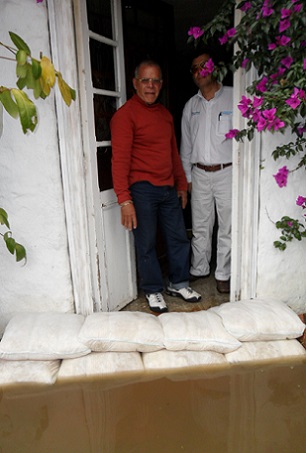 Flooding. Photo by Todd Trapani on Pexels resized
Flooding. Photo by Todd Trapani on Pexels resized
 FloodSax alternative sandbags preventing filthy floodwater getting into a house
FloodSax alternative sandbags preventing filthy floodwater getting into a house
All the vital information you need about flooding in the US
List of weather warning websites and flooding safety information you must follow
A flood happens somewhere in the US almost every day costing the country an estimated $8bn every year and claiming around 90 lives.
The figures mark 2021 Flood Awareness Week in the USA which runs from March 15 until March 19.
The National Weather Service says it’s vital that homes and businesses need to be prepared for flooding 24/7 to reduce the colossal cost and human misery caused by flooding.
To find out if you live on a floodplain go to the Federal Emergency Management Agency (FEMA) online map at https://msc.fema.gov/portal/home
If flooding seems likely then keep right up-to-date with these National Weather Service websites:
https://water.weather.gov/ahps/
https://mobile.weather.gov/#typeLocation
Emergency information can also be found at the National Oceanic and Atmospheric Administration at https://www.weather.gov/nwr/
Don’t forget that wireless emergency alerts for flash flood warnings are available on most smartphones at https://www.weather.gov/wrn/wea
Preparing for a flood
Check if your insurance covers flood damage. If not, find out how to get flood insurance.
Look to protect your home or business with flood prevention devices such as FloodSax alternative sandbags which are dual purpose. They stop floodwater getting in and can also be used to soak up leaks and spills, especially in hard-to-reach places. More at www.floodsax.com
Prepare a family disaster plan so everyone knows what to do in a flooding crisis.
Make an itemized list of your possessions well in advance in case any are damaged by floodwater. Photograph or video featuring both the inside and exterior of your home or business.
Keep insurance, important documents and other valuable items in a safe deposit box.
Assemble a disaster supplies kit such as emergency food, blankets, warm clothes, a cellphone, prescription medicines and your credit card.
Decide in advance where you can go and who you can stay with if ordered to evacuate.
During a flood
Avoid areas vulnerable to sudden flooding.
Never try to walk or drive through floodwater as just 6 inches of fast-moving floodwater can knock you off your feet and 2ft is enough to lift a car up and float it away.
Boil all drinking water in case the water system has become polluted and throw away any fresh food which has come into contact with floodwater.
For more information go to https://www.weather.gov/safety/flood